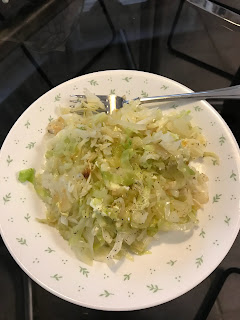On our week off between projects we visited our Korean friend, Bongwol, in Houston, TX. We had met at YWAM Lausanne, Switzerland in October, 2012, when we were both Mission Builders there.
We had a great visit. Bongwol served interesting things for breakfast: This is fried cabbage, with an egg is hidden in the middle of the “nest”. It was surprisingly tasty!
Since my mother was born in the Czech part of Czechoslovakia, and my father came from Moravia, I found the fact that many from this country had previously emigrated to America fascinating. Why did they do it? Freedom. In the old Austro-Hungarian Empire, before it was united as Czechoslovakia in 1918, farmers were still under the feudal system. The availability of land in America in the Blackland Prairie region, as well as the political situation, drew them to emigrate by the thousands.
Czechs brought with them their culture, a part of which brings me back to my story
I have been to the Czech Republic ten times, and I am well acquainted with the koláč.
It's a yeast dough pastry with a filling of fruit, quark cheese, or a paste made from poppyseeds. My parents even had these traditional delicacies at their wedding. Here's a picture of a Moravian variety Terry and I sampled in 2018. This pizza-sized one was sold with various flavours on the same plate. Tom is cutting them up so we could taste them all.
 |
| My cousin's husband, Tom |
I found out the koláč came to America, too. I knew it wouldn't be the same, but I was eager to taste-test this American variety, called kolache. We managed to track some down at Prasek's Smokehouse in Sealy, TX. They were displayed with meat pastries that looked like pigs in blankets, also called kolache. [Technically incorrect! Czechs don't call meat pastries by that name.] I carefully chose my apricot kolache. I found the name amusing. The plural form of koláč in Czech is koláče, which is what Americans call one pastry. I carefully carried the little white paper bag out to the car, and happily anticipated our lunch dessert.
Meanwhile, Terry was on a mission. He was trying to find a certain state park, but the GPS was not co-operating at all. We kept travelling down secondary roads, back and forth, until lunch was long overdue. I have to eat pretty much on time, so I wasn't happy. About an hour and a half later, I couldn't stand it any longer. “Just eat, then,” said Terry.
“But I wanted to eat the kolache with ceremony,” I explained. It was not to be. I ended up eating my kolache, while Terry focused on the road. I took a bite before I remembered I was supposed to photograph my kolache, sitting on the dash looking fresh and delicious.
I'm so grateful to Terry for stopping to find the kolache. We had in mind to stop at another bakery the next day which was famous for achieving the “best kolache” award, but we never got there. The next morning a winter storm warning sent us straight home to Edinburg, instead of exploring yet another state park we had in mind,and stopping at the bakery.
That's ok. I sampled my American kolache.
We both decided it wasn't at all the same as a real koláč. It was lighter, the dough fluffier, and the filling much sweeter. Delicious, but definitely not a koláč.
Here's a picture of some soup noodles I bought as well.






No comments:
Post a Comment